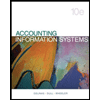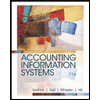
Concept explainers
1.
Concept introduction:
Predetermined
Predetermined overhead allocation is a method of allocation of overhead costs to the product units. Under this method, the overhead costs are allocated to the product units using the allocation base. The allocation base is identified based on the type of production activities.
To calculate: The amount of overhead cost assigned to the job.
2.
Concept introduction:
Predetermined overhead allocation:
Predetermined overhead allocation is a method of allocation of overhead costs to the product units. Under this method, the overhead costs are allocated to the product units using the allocation base. The allocation base is identified based on the type of production activities.
To calculate: The unit product cost for the job.
Want to see the full answer?
Check out a sample textbook solution
Chapter 2 Solutions
MANAGERIAL ACCOUNTING FOR MANAGERS EBOOK
- Which of the following is the most appropriate way to display liabilities on the balance sheet? a. alphabetically by payee b. relative likelihood of payment c. nearness to maturity d. All of these answer choices are correct.arrow_forwardCan you help me with accounting questionsarrow_forwardFor which of the following would year-end accrual of a current liability be optional? a. Current portion of a long-term lease obligation that comes due next year b. A declared property dividend c. Sick pay benefits that accumulate but do not vest d. Short-term debt that is being refinanced on a long-term basisarrow_forward
- Quick answer of this accounting questionsarrow_forwardSwifty Supply Co. has the following transactions related to notes receivable during the last 2 months of 2027. The company does not make entries to accrue interest except at December 31. Nov. 1 Loaned $30,000 cash to Manny Lopez on a 12 month, 10% note. Dec. 11 Sold goods to Ralph Kremer, Inc., receiving a $85,500, 90-day, 8% note. 16 Received a $87,840, 180 day. 10% note to settle an open account from Joe Fernetti. 31 Accrued interest revenue on all notes receivable. (a) Journalize the transactions for Swifty Supply Co. (Ignore entries for cost of goods sold.) (Credit account titles are automatically indented when amount is entered. Do not indent manually. Use 360 days for cal in the order presented in the problem. List all debit entries before credit entries.) Date Account Titles and Explanation Debit Creditarrow_forwardHi expert please give me answer general accounting questionarrow_forward
- Howard James started a business in 2011 in Jamaica and has been operating in the wholesale/retail industries, where he buys and sells household items to the local market. In 2012, he expanded his business operations and opened two other businesses in Trinidad and Tobago and Antigua and Barbuda, respectively. The annual sales of the respective businesses in 2015 are: Jamaica: J$3,000.00 Trinidad and Tobago: TT$251,000.00 Antigua and Barbuda: $299.00 Mr. James failed to register his business for VAT/GCT as specified by the respective Sales Tax Acts and Regulations. He stated that there is no need for his businesses to be registered because their sales are under the VAT thresholds and thus not required to be registered. a) You are to advise Mr. James if his decision not to register his businesses is justifiable. b) Search the respective VAT Acts for the 3 countries and advise Mr. James of the benefits of being a registered taxpayer; also the penalties for not registering for VAT/GCT.arrow_forwardGet correct answer general accounting questionarrow_forwardPLEASE HELP FILL THESE CELLS. NOTICE I HAVE PROVIDE THE OPTIONS ON THE DROP DOWNarrow_forward
 Managerial Accounting: The Cornerstone of Busines...AccountingISBN:9781337115773Author:Maryanne M. Mowen, Don R. Hansen, Dan L. HeitgerPublisher:Cengage Learning
Managerial Accounting: The Cornerstone of Busines...AccountingISBN:9781337115773Author:Maryanne M. Mowen, Don R. Hansen, Dan L. HeitgerPublisher:Cengage Learning Pkg Acc Infor Systems MS VISIO CDFinanceISBN:9781133935940Author:Ulric J. GelinasPublisher:CENGAGE L
Pkg Acc Infor Systems MS VISIO CDFinanceISBN:9781133935940Author:Ulric J. GelinasPublisher:CENGAGE L Accounting Information SystemsFinanceISBN:9781337552127Author:Ulric J. Gelinas, Richard B. Dull, Patrick Wheeler, Mary Callahan HillPublisher:Cengage Learning
Accounting Information SystemsFinanceISBN:9781337552127Author:Ulric J. Gelinas, Richard B. Dull, Patrick Wheeler, Mary Callahan HillPublisher:Cengage Learning Intermediate Accounting: Reporting And AnalysisAccountingISBN:9781337788281Author:James M. Wahlen, Jefferson P. Jones, Donald PagachPublisher:Cengage Learning
Intermediate Accounting: Reporting And AnalysisAccountingISBN:9781337788281Author:James M. Wahlen, Jefferson P. Jones, Donald PagachPublisher:Cengage Learning



